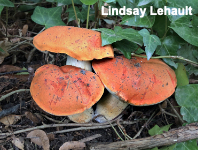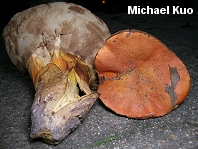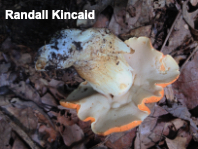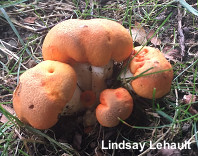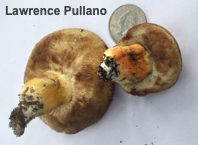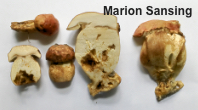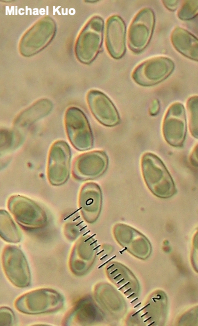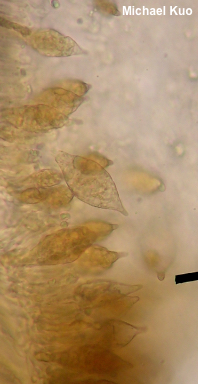| Major Groups > Boletes > Tylopilus > Tylopilus balloui |

|
Tylopilus balloui [ Basidiomycetes > Boletales > Boletaceae > Tylopilus . . . ] by Michael Kuo This Tylopilus is unmistakable when fresh. Its cap is bright reddish orange and its brown-bruising pore surface is whitish. However, the bright colors soon begin to fade, and eventually Tylopilus balloui becomes yet another boring, tan bolete. What is it with the pigments in Tylopilus? The purple shades in Tylopilus rubrobrunneus and Tylopilus plumbeoviolaceus are also short-lived, and the genus seems bent on demonstrating that the splendors of youth fade into boring, monotonous conformity. However, middle-aged mushroomers should be encouraged by the fact that other mushrooms, like Pluteus aurantiorugosus, hold their colors well into old age. Tylopilus balloui was combined into Rubinoboletus by Heinemann & Rammeloo (1993), but more recent studies (Halling et al. 2008; Osmundson & Halling 2010) confirm its position in Tylopilus. However, according to Halling et al. (2008), "T. balloui as currently circumscribed represents a species complex rather than a single species." One balloui-like species, Tylopilus oradivensis, has been named from Costa Rica; others may be separated in the future. Tylopilus ballouii is an alternate spelling. Thanks to Lindsay Lehault, Randall Kincaid, Lawrence Pullano, and Marion Sansing for collecting, documenting, and preserving Tylopilus balloui for study; their collections are deposited in The Herbarium of Michael Kuo. Description: Ecology: Mycorrhizal with hardwoods (especially oaks and beech) but occasionally reported with pines; growing alone, scattered, or gregariously; summer and fall; primarily southeastern in distribution but reported from as far north as New York and Massachusetts. The illustrated and described collections are from Maryland, Mississippi, Missouri, New Jersey, and Virginia. Cap: 3–12 cm; convex, becoming broadly convex or nearly flat in age; dry; fairly bald or, when young, finely velvety; bright reddish orange when young, soon fading to reddish brown, cinnamon brown, or tan. Pore Surface: Creamy whitish; bruising brown; eventually brownish; pores circular to angular, 1–2 per mm; tubes to 1 cm deep. Stem: 2.5–10 cm long; 1.5–2.5 cm thick; equal or with a swollen base; dry; bald, or finely reticulate near the apex; usually orangish when young, becoming whitish to yellow or orange—but sometimes bright orange or brownish orange. Flesh: White; soft; unchanging when sliced, or staining brownish. Odor and Taste: Taste mild or slightly bitter; odor not distinctive. Spore Print: Pale brown to reddish brown or purplish brown. Microscopic Features: Spores 6–8 x 4–5 µm; ellipsoid; smooth; hyaline and often uniguttulate in KOH; inamyloid. Hymenial cystidia 35–65 x 5–25 µm; lageniform to widely lageniform; occasionally mucronate; smooth or slightly roughened; golden yellow in KOH. Pileipellis a partially gelatinized cutis of cylindric elements 2.5–7.5 µm wide; exserted ends cylindric with rounded apices; golden yellow to orangish yellow in KOH. REFERENCES: (Peck, 1911) Singer, 1947. (Snell & Dick, 1970; Smith, Smith & Weber, 1981; Weber & Smith, 1985; Phillips, 1991/2005; Lincoff, 1992; Metzler & Metzler, 1992; Both, 1993; Bessette, Roody & Bessette, 2000; Miller & Miller, 2006; Kuo, 2007; Ortiz-Santana et al., 2007; Halling et al., 2008; Kuo & Methven, 2010; Osmundson & Halling, 2010; Kuo & Methven, 2014; Baroni, 2017; Elliott & Stephenson, 2018.) Herb. Kuo 07281701, 07051801, 08131801, 08191801, 10101801. This site contains no information about the edibility or toxicity of mushrooms. |
© MushroomExpert.Com |
|
Cite this page as: Kuo, M. (2018, November). Tylopilus balloui. Retrieved from the MushroomExpert.Com Web site: http://www.mushroomexpert.com/tylopilus_balloui.html |
